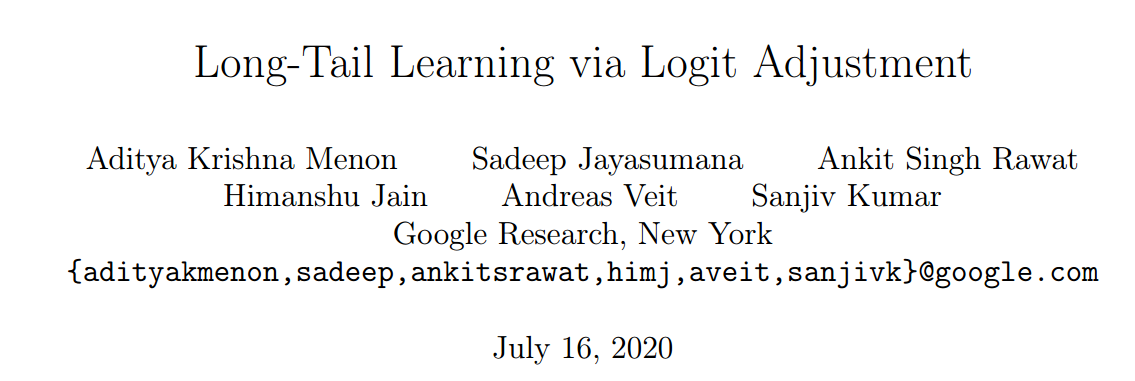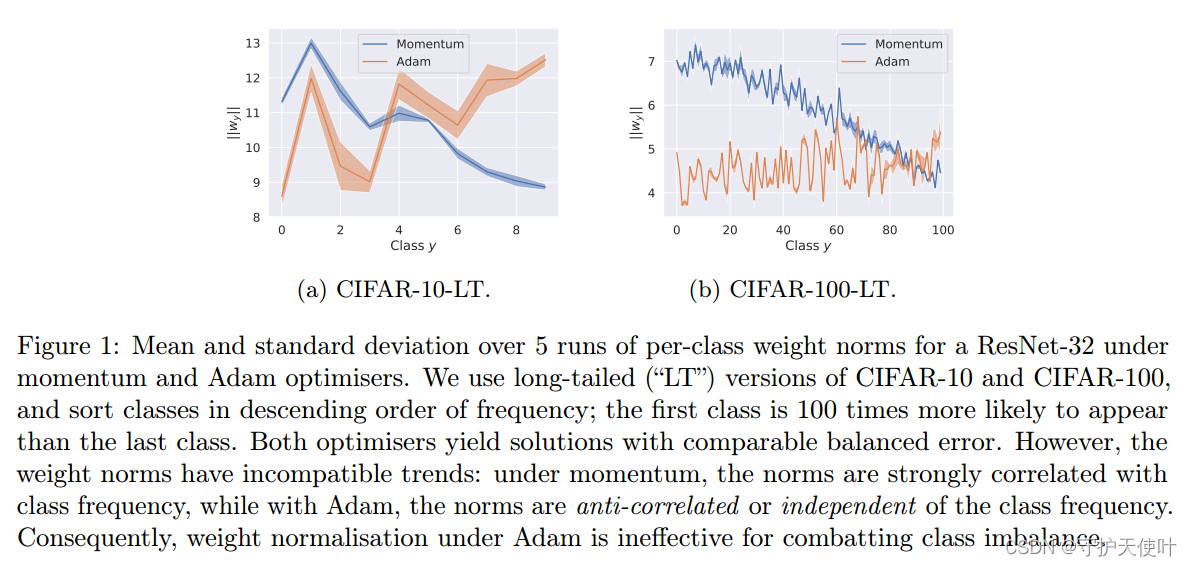
论文阅读:Long-Tail Learning via Logit Adjustment
post-hoc normalisation,调整学习完的logit,但这样容易受到优化器选择的影响。loss modification,通过调整损失函数来调整logit,以适应不同类的惩罚,但这样牺牲了连续性,这样优化结果不一定是最优。提出了两个logit adjustment的两个post-hoc normalization和loss modification的实现,克服了两种问题的局限。证实
论文阅读:Long-Tail Learning via Logit Adjustment
这篇论文写的是一种长尾识别的方式,方法是logit adjustment。这篇博文记录读这篇论文时的理解。
文章目录
概述
两种处理长尾问题的方式与其局限:
- post-hoc normalisation,调整学习完的logit,但这样容易受到优化器选择的影响。
- loss modification,通过调整损失函数来调整logit,以适应不同类的惩罚,但这样牺牲了连续性,这样优化结果不一定是最优。
主要贡献:
- 提出了两个logit adjustment的两个post-hoc normalization和loss modification的实现,克服了两种问题的局限。
- 证实了所提出的技术在真实世界数据集上的效用
- 提出了softmax交叉熵的一般版本,pairwise label margin
一、Problem setup and related work
1. Problem setup
对于分布
P
\mathbb{P}
P,采样出
S
=
{
(
x
n
,
y
n
)
}
n
=
1
N
∼
P
N
S = \left\{ (x_n , y_n) \right\}_{n = 1}^{N} \sim\ \mathbb{P}^N
S={(xn,yn)}n=1N∼ PN,作为数据集。我们的目标是用数据集训练出模型
f
:
χ
→
R
L
f:\chi \rightarrow \mathbb{R}^L
f:χ→RL,使得分类误差最小。将
p
(
x
)
=
[
p
1
(
x
)
,
.
.
.
,
p
L
(
x
)
]
ϵ
Δ
∣
y
∣
p(x) = [p_1(x),...,p_L(x)]\epsilon \Delta_{|y|}
p(x)=[p1(x),...,pL(x)]ϵΔ∣y∣看作是
P
(
y
∣
x
)
\mathbb{P}(y|x)
P(y∣x)的估计。
在长尾学习中,
P
(
y
)
\mathbb{P}(y)
P(y)非常不平衡,头部类的概率很高,尾部类的概率很低。由贝叶斯公式可知
P
(
y
∣
x
)
∝
P
(
y
)
P
(
x
∣
y
)
\mathbb{P}(y|x) \propto \mathbb{P}(y)\mathbb{P}(x|y)
P(y∣x)∝P(y)P(x∣y),因此
P
(
y
∣
x
)
\mathbb{P}(y|x)
P(y∣x)也头部概率很高,尾部概率很低。因此会偏向于向多数类划分。
为了应对这样的问题,采用一个平衡后的式子
P
b
a
l
(
y
∣
x
)
∝
1
L
P
(
x
∣
y
)
\mathbb{P}^{bal}(y|x) \propto \frac{1}{L}\mathbb{P}(x|y)
Pbal(y∣x)∝L1P(x∣y),来衡量某样本往个各类划分的概率。因此的到了平衡后的误差BER:

P
(
x
∣
y
)
\mathbb{P}(x|y)
P(x∣y)相当于固定一个类,看每个x的概率,因此BER相当于是:求每个类似然,然后求均值。
2. Related work
-
Post-hoc weight normalisation。训练后调整logit,减小多数类权值的范数,提高少数类权值的范数。假设一个分类器 f y ( x ) = w y T ϕ ( x ) f_y(x) = w_y^T\phi(x) fy(x)=wyTϕ(x),其中 w y ϵ R D w_y \epsilon \mathbb{R}^D wyϵRD为类别 y y y的分类器权重, ϕ : χ → R D \phi : \chi \rightarrow \mathbb{R}^D ϕ:χ→RD是特征提取器。

其中 v y v_y vy可以选择 P ( y ) \mathbb{P}(y) P(y)或者 ∣ ∣ w y ∣ ∣ 2 ||w_y||_2 ∣∣wy∣∣2。 -
Loss modification。调整损失函数。
在原来的损失之前加一个 p ( y ) \mathbb{p}(y) p(y)的倒数,但是效果并不是很好。

将分类边界靠近多数类,其中 e δ ∝ P ( y ) − 1 / 4 e^{\delta} \propto\mathbb{P(y)}^{-1/4} eδ∝P(y)−1/4。

稀少类经常会收到一个很强的梯度抑制信号,因为模型会认为对于主类来说,稀少类是一种负例。因此还有一种loss,其中 δ y < = 0 \delta_y<=0 δy<=0是 P ( y ′ ) \mathbb{P}(y') P(y′)的非递减的转化。

-
现存方法的局限
Limitations of weight normalisation:该方式是基于权重范数 ∣ ∣ w y ∣ ∣ 2 ||w_y||_2 ∣∣wy∣∣2与 P ( y ) \mathbb{P(y)} P(y)相关,但是这十分依赖优化器的选择,从图中可以看出使用momentum和Adam优化器时的 P ( y ) \mathbb{P(y)} P(y)差别极大。

Limitations of loss modification:不能保证Fisher consistency。也就是说,loss最小时,balanced error也应该是最小的,但是上述两种loss都不能保证。
二、Logit adjustment for long-tail learning: a statistical view
根据之前的problem setup,我们的目标是找到一个模型
f
f
f使得BER(
f
f
f)最小,即
f
∗
ϵ
a
r
g
m
i
n
f
:
χ
→
(
R
)
L
B
E
R
(
f
)
f^*\epsilon argmin_{f:\chi \rightarrow \mathbb(R)^L}BER(f)
f∗ϵargminf:χ→(R)LBER(f)。下式成立:

其中
P
b
a
l
(
y
∣
x
)
∝
P
(
x
∣
y
)
∝
P
(
y
∣
x
)
P
(
y
)
\mathbb{P}^{bal}(y|x) \propto \mathbb{P}(x|y) \propto \frac{\mathbb{P}(y|x)}{\mathbb{P}(y)}
Pbal(y∣x)∝P(x∣y)∝P(y)P(y∣x),假设
P
(
y
∣
x
)
∝
e
s
y
∗
(
x
)
\mathbb{P}(y|x) \propto e^{s_y^*(x)}
P(y∣x)∝esy∗(x),
s
:
χ
→
R
L
s:\chi \rightarrow \mathbb{R}^L
s:χ→RL,则(7)式变为下式:

从(8)式中可以看出,能够利用
P
(
y
)
\mathbb{P}(y)
P(y)来修正logit,从而最小化
B
E
R
(
f
)
BER(f)
BER(f)。
post-hoc:训练模型估计
P
(
y
∣
x
)
\mathbb{P}(y|x)
P(y∣x),然后按照(8)显式调整logit;
loss modification:在训练模型估计
P
(
y
∣
x
)
\mathbb{P}(y|x)
P(y∣x)时,按照(8)隐试地修正logit。
三、Post-hoc logit adjustment
在数据集上训练
f
y
(
x
)
=
w
y
T
ϕ
(
x
)
f_y(x) = w_y^T\phi(x)
fy(x)=wyTϕ(x),则(8)式就变换为下式:

(9)式相当于为每个logit加了一个偏置,这个偏置依赖于标签。
π
\pi
π是类先验概率
P
(
y
)
\mathbb{P}(y)
P(y)的估计,
τ
\tau
τ是一个超参数。
post-hoc logit adjustment相对于post-hoc weight normalization更有优势。这两种方式的调整如下图所示:

左侧为post-hoc weight normalization,是做乘法;右侧为post-hoc logit adjustment,化简之后可以成为
f
y
(
x
)
−
τ
⋅
l
o
g
π
y
f_y(x)-\tau \cdot log\pi_y
fy(x)−τ⋅logπy,相当于是做加法。
对于post-hoc weight normalization,如果一个少数类得到的score是负数,其他类的score是正数,那么这个少数类只能是最小的,对于这种方法不可能让少数类获得高的score;
而对于post-hoc logit adjustment,因为做的是加法,及时score是负数,也可以通过后一项调整,给少数类很高的score,还降低了主类的score。
三、The logit adjusted softmax cross-entropy
在训练时修改logit,给出基于softmax cross-entropy的loss,如下式:

可以看做
g
(
x
)
=
f
y
(
x
)
+
τ
⋅
l
o
g
π
y
g(x) = f_y(x) + \tau \cdot log \pi_y
g(x)=fy(x)+τ⋅logπy,将
g
(
x
)
g(x)
g(x)带入了基本的softmax cross-entropy。相当于一种Post-hoc logit adjustment的方式:
a
r
g
m
a
x
y
ϵ
[
L
]
f
(
x
)
=
a
r
g
m
a
x
y
ϵ
[
L
]
g
(
x
)
−
τ
⋅
l
o
g
π
y
argmax_{y \epsilon[L]}f(x) = argmax_{y \epsilon[L]}g(x)-\tau \cdot log\pi_y
argmaxyϵ[L]f(x)=argmaxyϵ[L]g(x)−τ⋅logπy。
作者给出了一般式,命名为pairwise margin loss:

该loss会使得正类和负类的margin变大。
更多推荐
 已为社区贡献1条内容
已为社区贡献1条内容







所有评论(0)